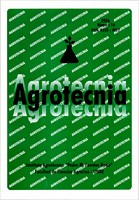Two different plantation densities in strawberry (Fragaria x ananassa duch.) cultivation in Colonia Benitez Chaco
DOI:
https://doi.org/10.30972/agr.0304663Keywords:
yield, number of fruits, fruit size, leaf diseasesAbstract
The aim of this work was to assess the agronomic performance in two strawberry (Fragaria x ananassa Duch.) plantation densities in Colonia Benítez, Chaco agroecological conditions. The study was carried out at EEA Colonia Benítez INTA, into a type of soil taxonomically classified as Argiudol oxic, corresponding to Tragadero Series. The transplantation was carried out on hills with Festival variety fresh plants in April. The planting was performed in rows of 30 cm spacing between rows and between 25 and 30 cm of distance among each other, resulting in two levels of plant density, T1 8 plants per meter and T2 6 plants per meter. The experimental design was made at complete randomised blocks with 4 statistical replications. Once a month, presence and incidence of foliar diseases were assessed. The fruit yield, number and size were recorded. Data were subject to analysis of variance, at significance level of 5% and comparing the means using Tukey test. The presence of foliar diseases was detected in both treatments throughout the whole observed period and the incidence was statistically higher in T1 when the environmental conditions were of high rainfall. The yield in grams per plant was not different among treatments; but the yield per unit area was higher in T1. The weight and number of fruits per plant were not different in the assessed densities.Downloads
Published
2020-12-21
How to Cite
Shindoi, M. M., Chamorro, D. L., Avico, E. L., & Sarco, P. C. (2020). Two different plantation densities in strawberry (Fragaria x ananassa duch.) cultivation in Colonia Benitez Chaco. Agrotecnia, (30), 105–111. https://doi.org/10.30972/agr.0304663
Issue
Section
Notas de Investigación



